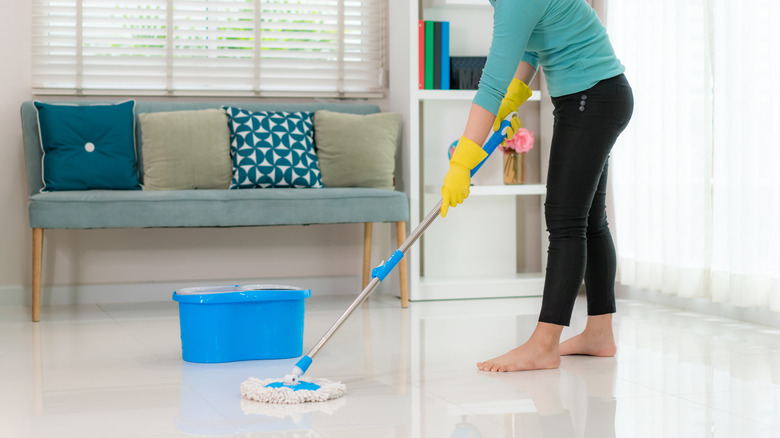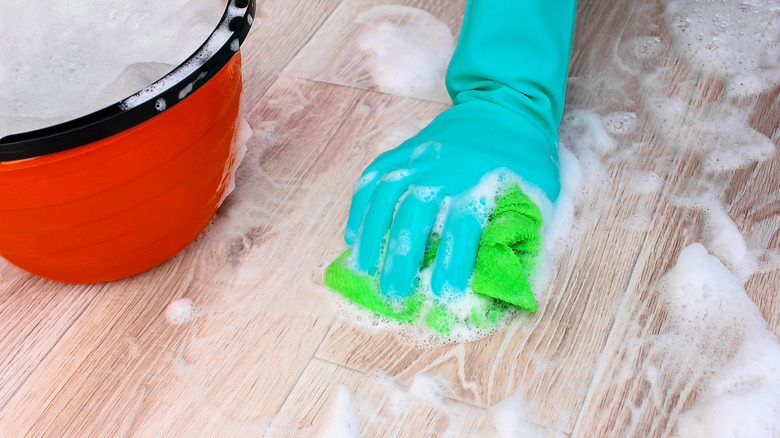How To Use Shampoo To Clean Your Ceramic And Linoleum Floors
Many people love ceramic and linoleum floors because they're great at keeping out water, need very little attention to stay clean, and can handle foot traffic without getting damaged. Keeping them clean and looking nice can be a real challenge though. Using the right cleaning methods is vital to avoiding stains, residue build-up, and damage. But sometimes, traditional floor cleaners just don't do the trick. Surprisingly, shampoo can be an effective solution for cleaning ceramic and linoleum floors.
Although shampoo is intended for hair care, it has remarkable potential as a cleaning agent for various surfaces, including floors. One of the main advantages of shampoo is its gentle yet effective nature, making it suitable for cleaning delicate surfaces. Shampoo is also versatile enough to handle tough stains and grime while being safe for regular use, promoting sustainable cleaning practices. Finally, it is an affordable option you may already have on hand.
Effectively cleaning floors with shampoo
For thorough cleaning, sweep or vacuum loose dirt and debris before mopping. Concentrate on high-traffic areas and corners where dirt accumulates. Once the floor is prepared, mix the shampoo solution by diluting one to two teaspoons of shampoo in a mop bucket filled with hot water. Choose the appropriate mop or cleaning tool for your floor type, such as a microfiber mop or cloth.
Apply the shampoo solution in small sections, gradually covering the whole area. Gently scrub to remove stubborn stains or dirt spots, with particular attention to grout lines on ceramic tiles. Avoid applying too much force, as this could damage the floor surface. (Here are a bunch of additional tips to keep in mind when cleaning tile floors.)
After scrubbing, let the solution sit for a few minutes. This will loosen and lift any remaining grime, improving the cleaning process's effectiveness. Then, use clean water and a separate mop or sponge to remove residual shampoo. Rinse thoroughly and wring out the mop or sponge as needed to prevent streaks or film on the floor. Finally, ensure the floor is adequately dried to prevent slips and falls. Use dry microfiber cloths or towels to pat dry the surface, removing excess moisture.
Considerations and precautions
Choosing the most suitable type of shampoo is crucial when using it to clean floors. Some shampoos may contain oils, conditioners, or other ingredients that can leave a residue on the floor. To avoid this issue, using a basic, sulfate-free hair shampoo without added conditioners is best. Clarifying shampoos, baby shampoos, or natural, eco-friendly hair shampoos can also work well for this purpose.
Although shampoo is generally safe for cleaning, it's still a good idea to perform a spot test in an inconspicuous area first to ensure compatibility with your specific flooring material and finish. Certain floors may have unique properties that could react differently to certain shampoos.
If your floors have been waxed or sealed with specific products, be cautious when using shampoo, as it may break down these protective layers and compromise the floor's appearance and durability. It's also important to note that shampoo may not have disinfectant properties like other cleaners, which could be an issue if you have small children.
While shampoo can be a cost-effective and eco-friendly swap, commercial cleaners specifically formulated for floor materials and finishes may be better for persistent stains, deep grime, or issues beyond regular cleaning.


